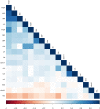Individual Factors Associated With COVID-19 Infection: A Machine Learning Study
- PMID: 35844896
- PMCID: PMC9279686
- DOI: 10.3389/fpubh.2022.912099
Individual Factors Associated With COVID-19 Infection: A Machine Learning Study
Abstract
The fast, exponential increase of COVID-19 infections and their catastrophic effects on patients' health have required the development of tools that support health systems in the quick and efficient diagnosis and prognosis of this disease. In this context, the present study aims to identify the potential factors associated with COVID-19 infections, applying machine learning techniques, particularly random forest, chi-squared, xgboost, and rpart for feature selection; ROSE and SMOTE were used as resampling methods due to the existence of class imbalance. Similarly, machine and deep learning algorithms such as support vector machines, C4.5, random forest, rpart, and deep neural networks were explored during the train/test phase to select the best prediction model. The dataset used in this study contains clinical data, anthropometric measurements, and other health parameters related to smoking habits, alcohol consumption, quality of sleep, physical activity, and health status during confinement due to the pandemic associated with COVID-19. The results showed that the XGBoost model got the best features associated with COVID-19 infection, and random forest approximated the best predictive model with a balanced accuracy of 90.41% using SMOTE as a resampling technique. The model with the best performance provides a tool to help prevent contracting SARS-CoV-2 since the variables with the highest risk factor are detected, and some of them are, to a certain extent controllable.
Keywords: COVID-19; feature selection; imbalanced data; machine learning; predictive model.
Copyright © 2022 Ramírez-del Real, Martínez-García, Márquez, López-Trejo, Gutiérrez-Esparza and Hernández-Lemus.
Conflict of interest statement
The authors declare that the research was conducted in the absence of any commercial or financial relationships that could be construed as a potential conflict of interest.
Figures
Similar articles
-
A new approach for determining SARS-CoV-2 epitopes using machine learning-based in silico methods.Comput Biol Chem. 2022 Jun;98:107688. doi: 10.1016/j.compbiolchem.2022.107688. Epub 2022 Apr 30. Comput Biol Chem. 2022. PMID: 35561658 Free PMC article.
-
A new hybrid ensemble machine-learning model for severity risk assessment and post-COVID prediction system.Math Biosci Eng. 2022 Apr 13;19(6):6102-6123. doi: 10.3934/mbe.2022285. Math Biosci Eng. 2022. PMID: 35603393
-
Prediction of death status on the course of treatment in SARS-COV-2 patients with deep learning and machine learning methods.Comput Methods Programs Biomed. 2021 Apr;201:105951. doi: 10.1016/j.cmpb.2021.105951. Epub 2021 Jan 22. Comput Methods Programs Biomed. 2021. PMID: 33513487 Free PMC article.
-
Comparative Studies on Resampling Techniques in Machine Learning and Deep Learning Models for Drug-Target Interaction Prediction.Molecules. 2023 Feb 9;28(4):1663. doi: 10.3390/molecules28041663. Molecules. 2023. PMID: 36838652 Free PMC article. Review.
-
Artificial intelligence in clinical care amidst COVID-19 pandemic: A systematic review.Comput Struct Biotechnol J. 2021;19:2833-2850. doi: 10.1016/j.csbj.2021.05.010. Epub 2021 May 7. Comput Struct Biotechnol J. 2021. PMID: 34025952 Free PMC article. Review.
Cited by
-
A large-scale machine learning study of sociodemographic factors contributing to COVID-19 severity.Front Big Data. 2023 Mar 24;6:1038283. doi: 10.3389/fdata.2023.1038283. eCollection 2023. Front Big Data. 2023. PMID: 37034433 Free PMC article.
-
Superspreading of SARS-CoV-2: a systematic review and meta-analysis of event attack rates and individual transmission patterns.Epidemiol Infect. 2024 Oct 8;152:e121. doi: 10.1017/S0950268824000955. Epidemiol Infect. 2024. PMID: 39377138 Free PMC article.
-
Artificial intelligence in triage of COVID-19 patients.Front Artif Intell. 2024 Dec 18;7:1495074. doi: 10.3389/frai.2024.1495074. eCollection 2024. Front Artif Intell. 2024. PMID: 39744742 Free PMC article.
-
AutoML-Driven Insights into Patient Outcomes and Emergency Care During Romania's First Wave of COVID-19.Bioengineering (Basel). 2024 Dec 15;11(12):1272. doi: 10.3390/bioengineering11121272. Bioengineering (Basel). 2024. PMID: 39768090 Free PMC article.
-
An adaptive data-driven architecture for mental health care applications.PeerJ. 2024 Mar 29;12:e17133. doi: 10.7717/peerj.17133. eCollection 2024. PeerJ. 2024. PMID: 38563009 Free PMC article.
References
-
- Organization WH . Virtual Press Conference on COVID-19-11 March 2020. Ginebra. (2020).
-
- Shailaja K, Seetharamulu B, Jabbar M. Machine learning in healthcare: a review. In: 2018 Second International Conference on Electronics, Communication and Aerospace Technology (ICECA). Coimbatore: IEEE; (2018). p. 910–4.
Publication types
MeSH terms
LinkOut - more resources
Full Text Sources
Medical
Miscellaneous



